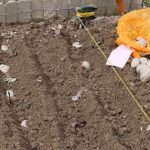Proper spacing is essential in vegetable gardening, especially when it comes to growing okra. In this article, we will explore the importance of spacing in okra gardening and how it can significantly impact the growth and yield of your plants.
Understanding the ideal spacing for okra plants involves considering various factors that contribute to their health and productivity. With a step-by-step guide to determining the right spacing and tips on maximizing utilization of space, you’ll be equipped with the knowledge and tools needed for successful okra gardening.
When it comes to proper spacing in okra vegetable gardening, there are several important factors to consider. One of these factors is ensuring that each plant has enough room for its roots to grow without competing for nutrients and water. Okra plants have extensive root systems, so providing them adequate space prevents overcrowding and promotes healthy root development.
Furthermore, proper spacing allows for good air circulation between okra plants, reducing the risk of fungal diseases such as powdery mildew or gray mold. Adequate space also facilitates access for sunlight, ensuring optimal photosynthesis and overall plant growth.
In addition to these benefits, proper spacing also enhances pollination efficiency by facilitating easy movement for bees and other beneficial insects between flowers. This ultimately contributes to better fruit set, leading to higher yields.
In the following sections, we will guide you through determining the right spacing for your okra plants in your garden using simple techniques. We will also discuss common mistakes to avoid and provide tips on maximizing your available space through companion planting and vertical gardening methods. So let’s dive into the world of okra spacing and discover how it can make all the difference in successful vegetable gardening.
Understanding the Ideal Spacing for Okra Plants
Proper spacing is crucial in okra vegetable gardening as it directly affects the growth and yield of the plants. Understanding the ideal spacing for okra plants is essential to ensure healthy growth and optimal production. There are several factors to consider when determining the spacing for your okra plants.
Firstly, it is important to consider the size of mature okra plants. On average, okra plants can grow up to 6 feet tall and spread out around 2-3 feet wide. To allow each plant enough space for adequate air circulation and sunlight exposure, it is recommended to leave a distance of at least 12-18 inches between each plant in a row.
Secondly, considering the soil fertility and nutrient requirements is vital for determining the ideal spacing. Okra plants have extensive root systems that require ample space to acquire nutrients from the soil. Providing enough space between plants allows for better nutrient absorption, resulting in healthier and more productive plants.
Another factor to consider is the climate and weather conditions in your region. In areas with high humidity or heavy rainfall, overcrowding can increase the risk of fungal diseases due to poor air circulation. Adequate spacing promotes better airflow between plants, reducing the chances of disease occurrence.
To determine the right spacing for your okra garden, it’s best to follow a step-by-step guide:
- Measure out your garden area: Use a measuring tape or yardstick to mark out your garden beds.
- Determine row spacing: Depending on your available space, decide on how far apart you want each row of okra plants.
- Measure individual plant spacing: Once you’ve decided on row spacing, measure and mark an appropriate distance (12-18 inches) between each individual plant within each row.
- Plant accordingly: Dig holes at each marked spot within the rows and plant your okra seeds or transplants accordingly.
- Maintain proper spacing: Regularly check and maintain proper spacing between plants as they grow, ensuring that they have enough room to thrive.
By understanding the factors affecting ideal spacing for okra plants and following a step-by-step guide, you can ensure optimal growth and yield in your okra vegetable garden.
Benefits of Adequate Spacing for Okra
Adequate spacing plays a crucial role in ensuring healthy growth and optimal yield of okra plants in your vegetable garden. By giving each plant enough space to grow and thrive, you can maximize the productivity of your okra crop. Here are some benefits of providing adequate spacing for your okra plants:
- Enhanced Air Circulation: Proper spacing allows for better air circulation between the plants, which reduces the chances of fungal diseases such as powdery mildew and molds. Good air circulation also helps to prevent moisture buildup on the leaves, minimizing the risk of bacterial or fungal infections. When plants are overcrowded, there is limited airflow, creating a favorable environment for disease development.
- Reduced Competition for Nutrients: Each okra plant requires a certain amount of nutrients to grow and produce a high-quality yield. With adequate spacing, each plant has access to an ample supply of nutrients from the soil without having to compete with neighboring plants. This promotes healthier root development, leading to sturdy plants and an increased yield.
- Avoidance of Shade Competition: Okra plants require full sun exposure for at least 6-8 hours daily to produce a bountiful harvest. When overcrowding occurs, taller or broader plants may cast shadows over their smaller neighbors, depriving them of sunlight they need for photosynthesis and growth. Adequate spacing ensures that each okra plant receives sufficient sunlight throughout the day, enhancing its overall health and productivity.
To ensure that you provide adequate spacing for your okra plants in your garden, follow these step-by-step guidelines:
- Determine Plant Spacing Requirements: Check the seed packet or nurseries’ recommendations for specific information about how far apart each okra plant should be spaced.
- Prepare Your Garden Beds: Clear any weeds or debris from the garden bed before planting your okra seeds or transplants.
- Measure Spacing Distances: Use a measuring tape or ruler to mark the recommended distance between plants. For example, if the recommended spacing is 12 inches, measure out 12 inches from the base of one plant and mark the spot for the next seed or transplant.
- Plant Your Okra: Dig a hole or trench according to the planting depth instructions provided. Place your okra seeds or transplants in the holes, ensuring they are properly spaced apart.
- Maintain Spacing Throughout Growth: As your okra plants grow, regularly check and adjust their spacing to ensure they have enough room to develop properly. If overcrowding occurs, you may need to thin out some plants by removing the weaker ones to maintain adequate spacing.
By following these guidelines and providing adequate spacing for your okra plants, you can promote healthy growth and optimize the yield of your vegetable garden. Remember that proper spacing is essential for minimizing disease risk, reducing competition for nutrients, and ensuring each plant receives adequate sunlight for photosynthesis.
Step-by-Step Guide
Proper spacing is essential for successful vegetable gardening, and okra plants are no exception. By providing adequate space between your okra plants, you can ensure healthy growth and optimal yield. In this step-by-step guide, we will walk you through the process of determining the right spacing for your okra plants in your garden.
- Consider the mature size of okra plants: Before planting okra, it’s important to understand how large the plants will grow. Okra plants can reach heights of 4 to 6 feet and produce broad leaves that can spread outwards. Keep these dimensions in mind when planning the spacing between each plant.
- Determine recommended spacing guidelines: The recommended spacing for okra plants is typically 12 to 18 inches apart in rows that are spaced about 3 feet apart. This allows enough room for each plant to grow and develop without being overcrowded.
- Measure and mark your garden beds: With a measuring tape or ruler, measure out the desired distance between each row in your garden bed, keeping in mind the recommended spacing guidelines. Use stakes or flags to mark these measurements and create straight rows.
- Dig planting holes: For each okra plant, dig a hole that is wide enough to accommodate the root ball of the plant and deep enough so that the soil level will be just above the top root once planted.
- Planting okra seedlings or seeds: Place one okra seedling or sow two to three seeds per hole at the recommended depth mentioned on the seed packet or as instructed by your local nursery. Cover them with soil and press down gently to secure them in place.
- Water thoroughly after planting: Once all your okra plants are planted, water them well using a gentle stream of water until fully saturated. This will help settle the soil around the roots and provide necessary moisture for the plants to establish themselves.
By following these step-by-step instructions, you can ensure that your okra plants have enough space to grow and thrive in your garden. Remember to monitor their growth throughout the season and make any necessary adjustments if you notice signs of overcrowding. Taking the time to properly space your okra plants will contribute to a successful vegetable gardening experience.
| Spacing Measurement | Recommended Spacing |
|---|---|
| Between rows | 3 feet apart |
| Between plants in a row | 12-18 inches apart |
Tools and Techniques for Measuring and Maintaining Proper Spacing in Okra Gardening
Maintaining proper spacing in your okra garden is crucial for the healthy growth and optimal yield of your plants. To achieve this, there are various tools and techniques you can use to measure and maintain the ideal spacing between your okra plants.
One of the most common tools used for measuring spacing in gardening is a measuring tape or ruler. Before planting your okra seeds or seedlings, measure the recommended distance between each plant as per its specific variety. This information can typically be found on the seed packet or plant label. Use the measuring tape to mark these distances on the ground or garden bed, ensuring that there is ample space for each okra plant to grow without overcrowding.
Another useful technique for maintaining proper spacing is using stakes or markers. Once you have measured and marked the spacing, insert stakes or markers at each spot to clearly indicate where each okra plant should be placed. This will help you visualize the layout of your gardening area and avoid any confusion when planting.
In some cases, using a string line can also be helpful. Stretch a string across your garden bed from one stake to another at the desired distance between plants. This creates a straight guideline for planting your okra seedlings. By following this line, you can ensure that your plants are spaced evenly in rows.
Regular monitoring of your okra garden is vital to maintaining proper spacing throughout the growing season. As your plants develop, they may require additional space due to their size and foliage spread. Use pruning shears or scissors to trim excess branches or leaves that are encroaching on neighboring plants. This will allow air circulation and prevent overcrowding.
By utilizing these tools and techniques for measuring and maintaining proper spacing in your okra gardening endeavors, you can provide an environment that promotes healthy growth and ultimately increases the yield of your crops. Remember, regular care and attention to spacing will help your okra plants thrive and produce abundant harvests.
Common Mistakes to Avoid
Proper spacing is key to successful okra gardening. One of the most common mistakes that gardeners make is overcrowding their okra plants. Overcrowding leads to competition for resources such as sunlight, nutrients, and water, which can stunt the growth of the plants and result in a lower yield. Additionally, overcrowded plants are more susceptible to diseases and pests as air circulation is limited.
Another mistake to avoid is underutilization of space in okra gardens. Okra plants have a tall and upright growth habit, with some varieties reaching heights of up to 6 feet. Therefore, it is important to optimize the use of vertical space in your garden by providing adequate spacing between each plant. This will not only ensure healthy growth but also make it easier for you to access and harvest the pods.
Spacing Guidelines
When it comes to spacing your okra plants, there are a few general guidelines that you can follow:
- Rows: Space your rows at least 3 feet apart to allow for easy maintenance and airflow between the plants.
- Within rows: Aim for a spacing of 12-18 inches between individual okra plants within the row. This will give them enough room to grow without overlapping or shading each other.
- Staggered planting: Consider staggering your planting by placing each plant offset from those in adjacent rows. This helps maximize the use of space and prevents a dense canopy from forming.
By following these spacing guidelines, you can ensure that your okra plants have enough room to thrive and provide you with an abundant harvest.
Benefits of Proper Spacing
Providing adequate spacing for your okra plants offers several benefits:
- Improved Air Circulation: Properly spaced plants allow air to circulate freely around each plant, reducing humidity levels and minimizing the risk of fungal diseases.
- Increased Sunlight Exposure: Ample spacing ensures that each individual plant receives sufficient sunlight, which is crucial for photosynthesis and overall plant health.
- Better Nutrient Absorption: When plants are not overcrowded, their root systems can develop fully and efficiently absorb the nutrients present in the soil, promoting healthier growth.
- Easier Maintenance and Harvesting: Ample space between plants makes it easier to tend to your garden by allowing you to move around without damaging or disturbing the plants. It also provides better access for harvesting the pods when they are ready.
Avoiding overcrowding and underutilization of space in your okra garden will help ensure healthy growth and optimal yield. By following proper spacing guidelines and understanding the benefits, you can set your okra plants up for success. In the next section, we will provide a step-by-step guide on how to determine the right spacing for okra plants in your garden.
Tips and Tricks for Maximizing Okra Spacing
Companion Planting
One effective way to maximize okra spacing in your garden is through companion planting. Companion plants are those that have beneficial effects on each other when grown in close proximity. By strategically choosing companion plants for your okra, you can create a mutually beneficial environment that allows for better space utilization and healthier growth.
A commonly recommended companion plant for okra is the marigold. Marigolds not only add a pop of color to your garden, but they also help deter pests that may be attracted to okra. Additionally, marigolds release chemicals into the soil that can suppress weeds, reducing competition for nutrients and space.
Another great option for companion planting with okra is beans. Beans are nitrogen-fixing plants, which means they can convert nitrogen from the air into a form that is usable by other plants. Okra requires a good amount of nitrogen to thrive, so planting beans nearby can help provide this essential nutrient naturally.
Vertical Gardening
Vertical gardening is another technique that can be used to maximize okra spacing in your vegetable garden. This method involves growing plants vertically instead of horizontally, which allows you to utilize vertical space more efficiently.
One popular way to implement vertical gardening with okra is by using trellises or stakes. Okra typically grows tall and upright, making it well-suited for this method. By providing support for the okra plants as they grow, you can save valuable ground space while still allowing them to reach optimal heights.
Using cages or mesh netting can also be an effective strategy in vertical gardening with okra. These structures allow the plant to grow outward rather than upward, creating more room for other crops or additional okra plants in your garden.
When implementing vertical gardening techniques with okra, it’s important to consider factors such as sunlight exposure and proper spacing between each plant to ensure sufficient air circulation and prevent overcrowding.
Overall, by incorporating companion planting and vertical gardening into your okra gardening practices, you can make the most of your available space and maximize your okra yield. These tips and tricks are not only practical but also environmentally friendly, as they promote natural pest control and nutrient cycling in your garden.
Frequently Asked Questions (FAQs)
As a vegetable gardener, it is natural to have questions about okra spacing. In this section, we will address some frequently asked questions and provide additional guidance on this important aspect of okra gardening.
- How far apart should I space my okra plants?
- Can I plant okra closer together to maximize my garden space?
- Is there any benefit to companion planting with okra?
The ideal spacing for okra plants is typically around 12-18 inches apart in rows that are 3-4 feet apart. This allows enough room for the plants to grow without crowding each other. Adequate spacing ensures good air circulation, which helps prevent diseases and promotes healthy growth.
While it may be tempting to plant okra closer together to make the most of limited garden space, overcrowding can actually harm the plants. When okra plants are too close together, they compete for sunlight, water, and nutrients, resulting in stunted growth and reduced yields. It is important to maintain the recommended spacing for optimal results.
Yes, companion planting can be beneficial when growing okra. You can companion plant with herbs like basil or marigolds to repel pests or attract beneficial insects. Additionally, planting tall companion plants like sunflowers or corn near okra can provide shade during hot summer months without casting too much shade on the growing area.
By addressing these frequently asked questions and providing additional guidance on proper spacing, you can ensure successful and rewarding okra gardening in your own backyard.
| Question | Answer |
|---|---|
| How far apart should I space my okra plants? | The ideal spacing for okra plants is typically around 12-18 inches apart in rows that are 3-4 feet apart. |
| Can I plant okra closer together to maximize my garden space? | While it may be tempting to plant okra closer together, overcrowding can harm the plants and result in stunted growth and reduced yields. |
| Is there any benefit to companion planting with okra? | Companion planting with herbs like basil or marigolds can repel pests, while tall companion plants can provide shade without casting too much shadow on the growing area. |
Conclusion
In conclusion, it is evident that proper spacing is a crucial factor in successful okra gardening. By understanding the ideal spacing for okra plants and considering factors such as sunlight, air circulation, and access to nutrients, gardeners can ensure healthy growth and optimal yield. It is important to follow a step-by-step guide to determine the right spacing for your okra plants in order to maximize their potential.
Using the right tools and techniques for measuring and maintaining proper spacing is essential. Gardeners should invest in measuring devices or markers to ensure accurate and consistent plant placement. Regular monitoring and maintenance of spacing will also help avoid common mistakes such as overcrowding or underutilization of space.
To further maximize okra spacing, gardeners can explore companion planting and vertical gardening techniques. Companion planting allows for the strategic placement of compatible plants that can benefit each other, while vertical gardening utilizes trellises or stakes to grow crops vertically, saving horizontal space. These methods not only optimize space but also enhance productivity.
Frequently Asked Questions
How far apart should okra plants be planted?
Okra plants should be planted approximately 12 to 18 inches apart. This spacing allows each plant to have enough room for proper growth and prevents overcrowding, which can lead to issues such as poor air circulation, increased disease susceptibility, and competition for resources like sunlight, water, and nutrients.
Additionally, adequate spacing between the plants enables easy access for maintenance tasks such as pruning, harvesting, and pest control.
How many okra plants in 4×4 raised bed?
In a 4×4 raised bed, you can typically fit about four okra plants. For each okra plant, leave a space of around 12 to 18 inches in all directions to ensure sufficient room for growth.
This spacing allows the plants to receive proper air circulation and access to sunlight without being too cramped. With four plants in a 4×4 raised bed, you will be optimizing the use of space while still providing each individual plant with enough area to thrive.
How many okra plants for a family of 4?
To provide enough okra for a family of four people, it is recommended to grow around eight to twelve okra plants. This number ensures an adequate supply of fresh okra throughout the growing season while accounting for variations in productivity and personal preferences.
It’s important to consider that different varieties may have varying yields and planting conditions can affect harvest quantities as well. By having a range of eight to twelve plants, you increase the likelihood of having a sufficient quantity of okra without ending up with an overwhelming surplus or shortage for your family’s needs.

If you’re looking to get into vegetable gardening, or are just looking for some tips on how to make your current garden better, then you’ve come to the right place! My name is Ethel and I have been gardening for years. In this blog, I’m going to share with you some of my best tips on how to create a successful vegetable garden.





